
You’ve picked up every houseplant on every beginner’s list, dipped your toe into some rare indoor plants, even started an expansive succulent garden on your windowsill – but you’re still itching for something more.
I know the feeling.
Houseplant collecting is an insatiable hobby. Once you’ve mastered one plant, it’s almost impossible to stop yourself from conquering every leafy being you can potentially grow indoors.
If you’re stuck in this position, I may have the solution for you. They may get a bad rap as the villains in horror movies or the stuff of children’s nightmares, but they’re very friendly once you get to know them, and an essential collector’s item. We’re talking about carnivorous plants.
What Are Carnivorous Plants?
Carnivorous plants are incredibly easy to define. Like other carnivores, they capture and kill prey. Whether it be a fly or a beetle, once trapped, the insects are digested by the plant for essential nutrients.
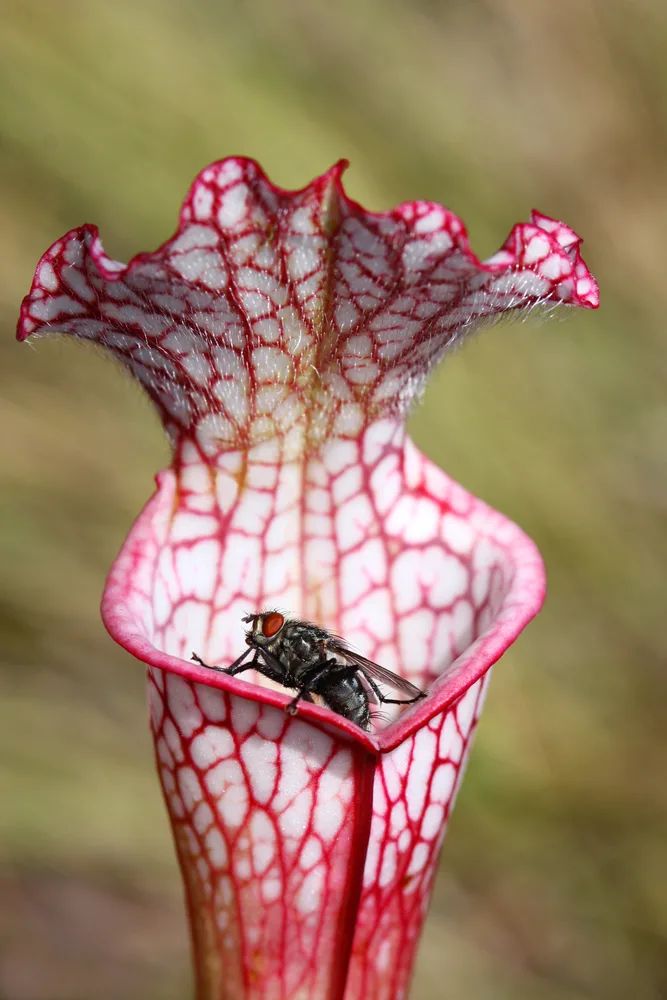
They hold a long history. These plants first appeared 70 million years ago after genes did what they do best in difficult times – mutate. Studies show that non-carnivorous plants, under pressure from a lack of nutrients, duplicated their DNA/genomes. These copies allowed them to diversify their purpose. Leaf and root DNA changed, allowing these plants to not only trap meaty prey but also absorb its nutrients.
As evolution dictated, their leaves and roots became redundant as they received their necessary nutrients from the prey. The original leaf and root genomes, therefore, began to disappear. Their environment also had an impact. Depending on where the plants were, they developed to fit the environment and attract the right kind of prey in their immediate area.
If their interesting history hasn’t convinced you to give them a go, perhaps their relatively easy-going nature will.
Carnivorous Plant Care
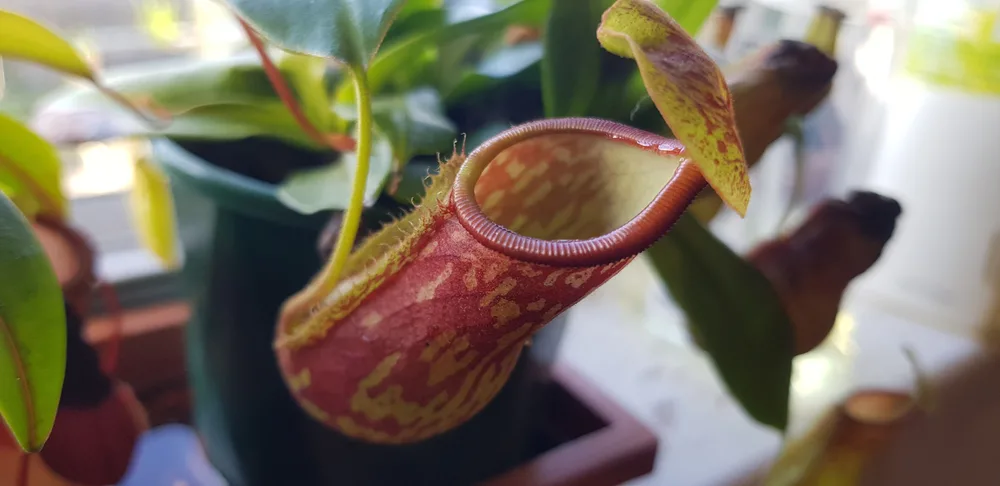
Water
The biggest rule when it comes to carnivorous plant care is to keep them watered. Because they’re native to bogs, swamps, and other water-dense areas, they need a lot of water to thrive.
You’ll want to keep their soil as moist as possible. The tray or saucer method is the easiest way to do this. Simply place your pot in a tray or saucer filled with water.
Depending on the type of carnivorous plant you decide to grow, you’ll need to keep an eye on the water levels. Most enjoy damp over wet soil. But some, those who love mushy soil like Pitcher Plant varieties, need soaking wet soil.
You can help the process along by opting for plastic pots. Plastic retains water better than terracotta or clay, even though it may not be as appealing.
The type of water you use is equally as important as how often you water. Carnivorous plants do best when watered with rainwater or distilled water, as tap water typically has too many minerals in it. You can find distilled water at your local grocery store, or easily collect rainwater in a bucket or barrel. Purified water will also do, as long as it’s been purified through reverse osmosis.
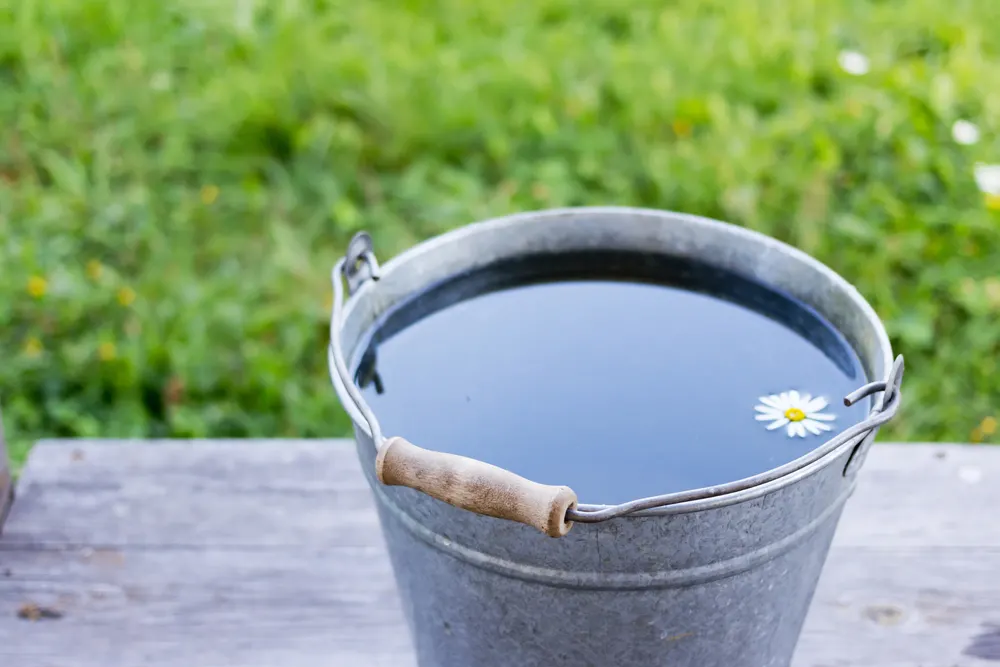
Soil
Carnivorous plants do best in low-quality soil with little to no nutrients. Different types require specific types of soil conditions. Generally, though, most enjoy peaty and sandy soil. A mix of peat-like products such as coconut coir and horticultural sand will easily do the trick.
Sand used in play boxes is a great alternative.
However, avoiding minerals in your sand and water is critical. Not just because they’re redundant, but because they can actually cause the plants’ roots to burn.
Fertilizer
On that note, fertilizers should be avoided at all costs. Your plant will get all its necessary nutrients from the prey it captures and digests.
Humidity
If you’ve been in bogs and swamps you’ll know that they can be pretty humid. To match that environment, keep humidity levels around your plant high. This also stops the plant from drying out.
The go-to method for increasing humidity around indoor plants is to add a humidifier to the room. Constantly keeping your plants wet will also do.
Temperature
Temperature preferences depend on the variety you opt for. Most don’t mind average temperatures. Some though, do best in warmer or cooler climates. Carnivorous plants are tolerant of temperature variances though and typically won’t mind a bit of change in either direction.
Light
Light is as important as water when it comes to carnivorous plants. They need plenty of light to thrive. Lots of sunlight brings out the lush red of many carnivorous plants that make them attractive.
Some varieties enjoy some partial shade. Others though require at least twelve hours of sunlight. Bear that in mind when picking your new addition to your indoor plant collection.
Pests and Diseases
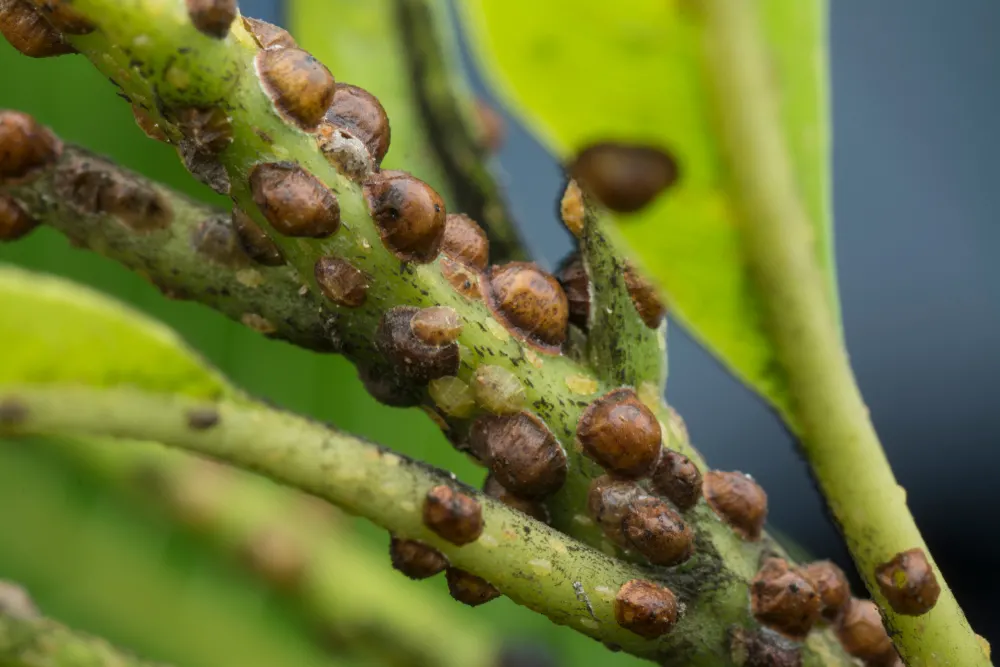
Yes, carnivorous plants do eat several pesky bugs. But there are a few that manage to evade their clutches. Aphids (surprise, surprise) do love to nibble on the lower growing leaves of the plant.
They’re generally easy to get rid of. Simply pick them off or blast them off using a water spray bottle. Aphids can overwinter within the plant though, which is the main concern.
Because you’ve got a swamp loving plant, you can easily submerge it in water for a few days, getting rid of those pesky aphids in one swoop.
High levels of humidity are important for the health of your carnivorous plants. But, with humidity comes higher chances of mold. Botrytis is a type of mold that these plants are quite susceptible to.
Increasing airflow is a must if you want to prevent this stuff from growing and taking hold. Pop your window open and ensure there is plenty of space around the plant. Healthy pruning habits are also a must. Remove dead foliage frequently and if the mold has started growing, remove the affected part immediately.
Other insects to keep an eye out for are scale insects. These tiny blister-like bugs tend to appear when mold is present. Get rid of them by wiping them with a cloth soaked in alcohol.
5 Carnivorous Plants To Grow Indoors
Venus Flytrap
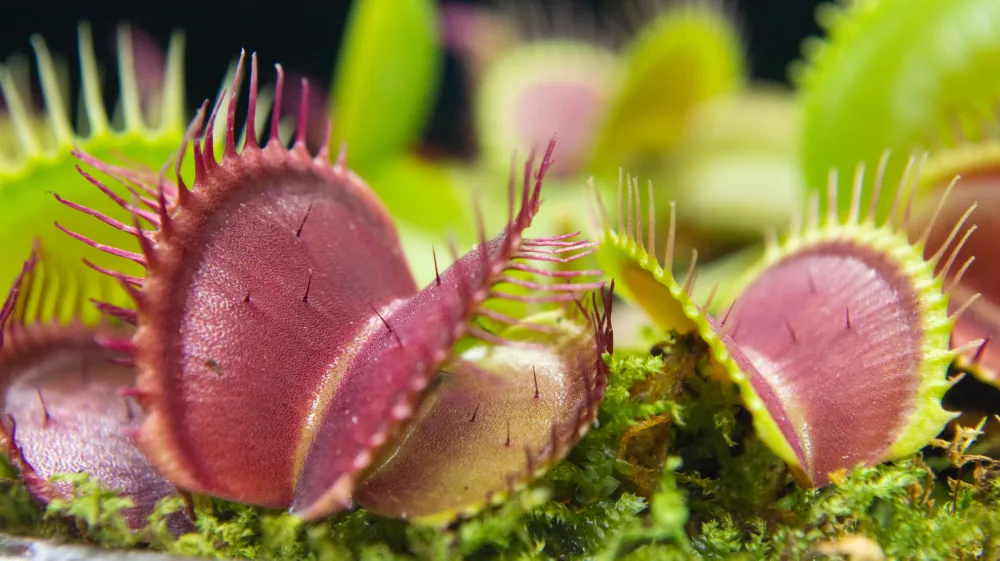
The Venus Flytrap is, without a doubt, the most commonly known carnivorous plant.
They’re relatively odd-looking, with their strange mouth-like traps. These are modified leaves and a single plant can have several of them. These mouths have nectar inside them that attracts their prey. The thin teeth-like growths along the edge of the trap are trigger hairs.
When the prey touches one of these, the mouth clamps shut, trapping the insect inside. The plant then excretes enzymes that digest the prey for just over a week. Once the prey has been devoured, the mouth reopens, enticing more insects to come on through.
One Species, Many Choices
Venus Flytrap (Dionaea muscipula) is the only species of this group. But several interesting cultivars are available for those wanting to grow something a little different.
If size matters you can opt for Dionaea ‘Petite Dragon’. This little guy’s traps are only about half an inch long. Where it lacks in size, it doesn’t in color. You’ll be treated with bright greens and maroons with this variety. Dionaea ‘Ginormous’, on the other hand, is much larger. Its traps measure just over 2 inches.
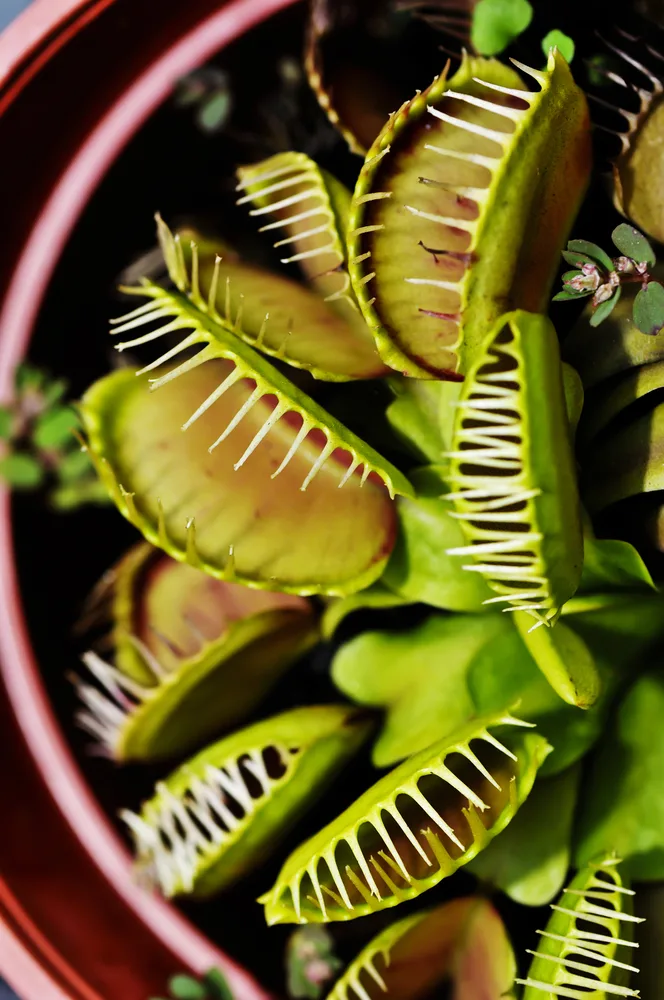
Color might be your deciding factor. If green is your color of choice, Dionaea ‘Justina Davis’ is definitely for you. This cultivar stays completely green, no matter how much sun it gets.
But for those maroon and red lovers out there, Dionaea ‘Akai Ryu’ or ‘Red Dragon’ is the best by far. It remains a gorgeous red throughout its life. If you’re not too fussed, you’ll be sure to be treated to a mix of greens, reds, and even purples with other cultivars.
Butterworts
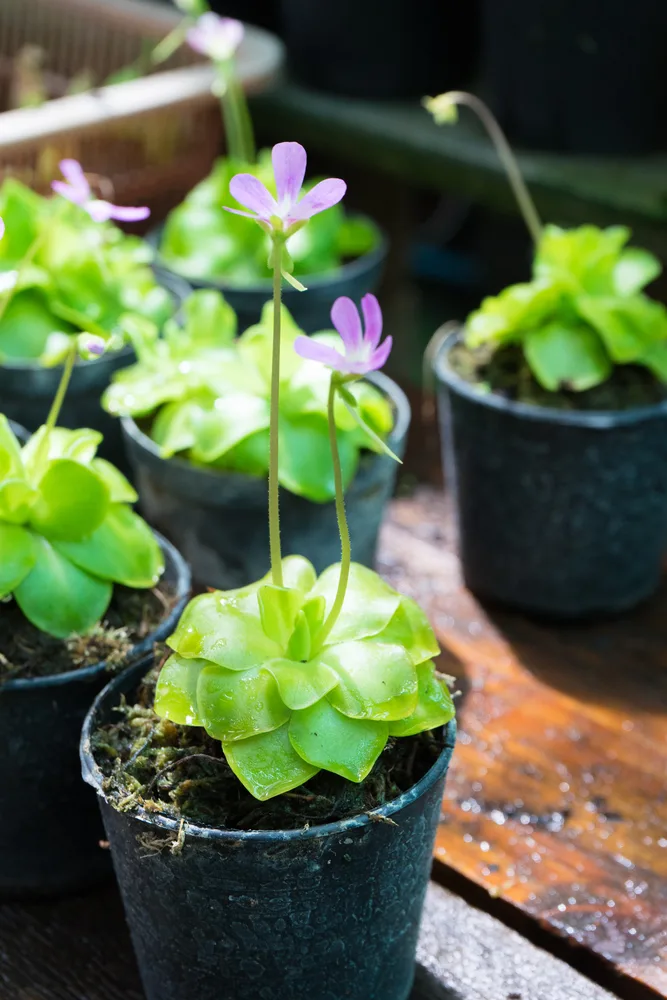
A carnivorous plant that many may not know is the humble Butterwort. These plants are lazy when it comes to trapping, using no movement at all to lure or catch their prey. Instead, its yellowish buttery leaves have a coating of resin that attracts and traps insects.
Its favorite meal is nitrogen-rich gnats. Fruit flies are another great choice for this plant. The resin is excreted via glands in the leaves, and as the insect struggles, more is released. Eventually, the gnat or fruit fly becomes fully encased in resin and digestion begins. All that remains are the insects’ exoskeletons.
Like many in the carnivorous plant family, butterworts are simple and easy to care for. They enjoy plenty of water and a healthy dose of sunlight.
Butterworts often have small flowers, blooming in spring. You’ll be treated to stunning shows of yellows, pinks, purples, and whites if you opt for this carnivorous plant.
There are over 80 species of butterworts to choose from, all varying in size and color variations. Some of the most popular buttoworts include Pinguicula agnata ‘True Blue’, Pinguicula moranensis ‘G’, Pinguicula grandiflora and Pinguicula gigantea.
‘True Blue’ has blooms that are of course, blue. If you’re wanting your plant to stand out on your windowsill then consider this one.
Pinguicula Grandiflora is more commonly known as the large-flowered butterwort. These flowers aren’t only bigger, but they look different too. They’re funnel-shaped, blooming in white, purple, or yellow. Even better, you’ll be treated with blooms throughout the warmer seasons.
For those who enjoy the look of succulents, then the Pinguicula gigantea will be to your taste. They have flowers too, which are usually purple.
Bladderworts
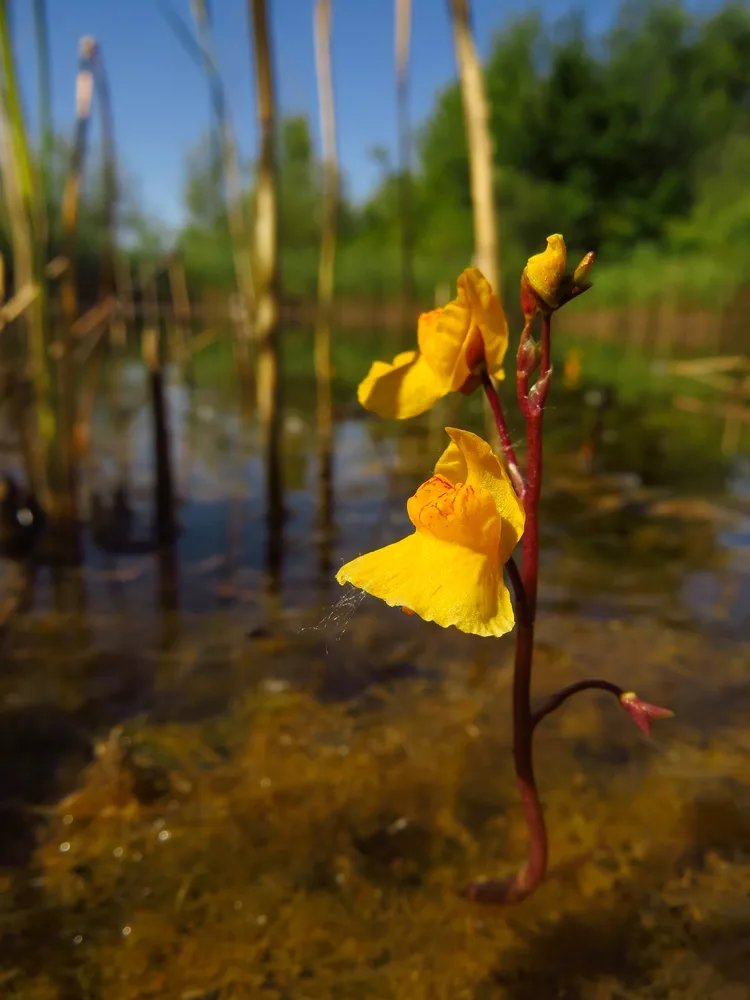
If trapping plants tickle your fancy, but you’re looking for something unorthodox, look no further than bladderworts.
Bladderworts (Utricularia) have a complicated trapping system. So much so that many believe it to be the most complex of all carnivorous plants.
The kicker though? It’s not on display, unlike venus flytraps. Instead, it’s hidden under the soil.
You can still enjoy its pretty flowers, often treating you to a variety of hues, from yellow to purple.
This carnivorous plant has tiny bladders hidden beneath the soil or water, depending on the variety you choose. The trapping mechanism is much the same. Its bladders (which are mutated leaves) have trigger hairs. When these are touched, a sort of trap door opens. This is lined with a substance that attracts a variety of insects, including mosquito larvae. Once trapped, the insect is digested.
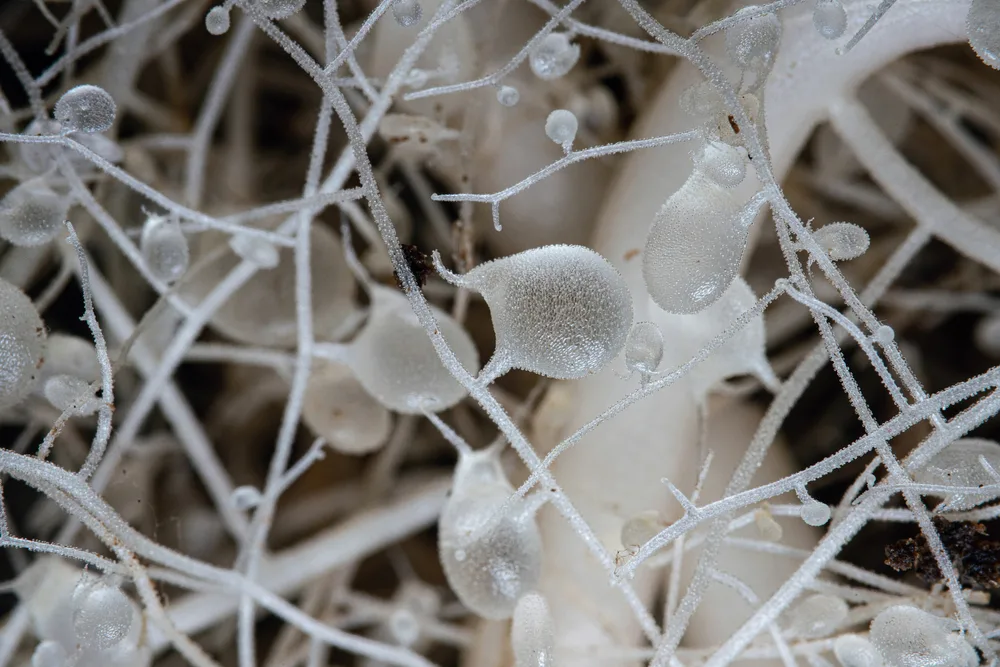
You can find over 200 species in the bladderwort family that can survive in almost any climate. The choices mainly come down to the type of bladderwort you want – terrestrial, aquatic, seasonal, or tropical. Each has different needs, especially when it comes to water.
Aquatic, you guessed it, needs a constant water source. The best way to meet these needs is to place your bladderwort in a pot that doesn’t drain. Terrestrial and seasonal types do best sitting in a tray full of water. Tropical, on the other hand, needs a drained container to thrive. Depending on the variety of tropical butterwort, you may want to consider higher levels of coir in your mixture.
If you’re looking for aquatic plants for your pond or water feature click here.
Sundews
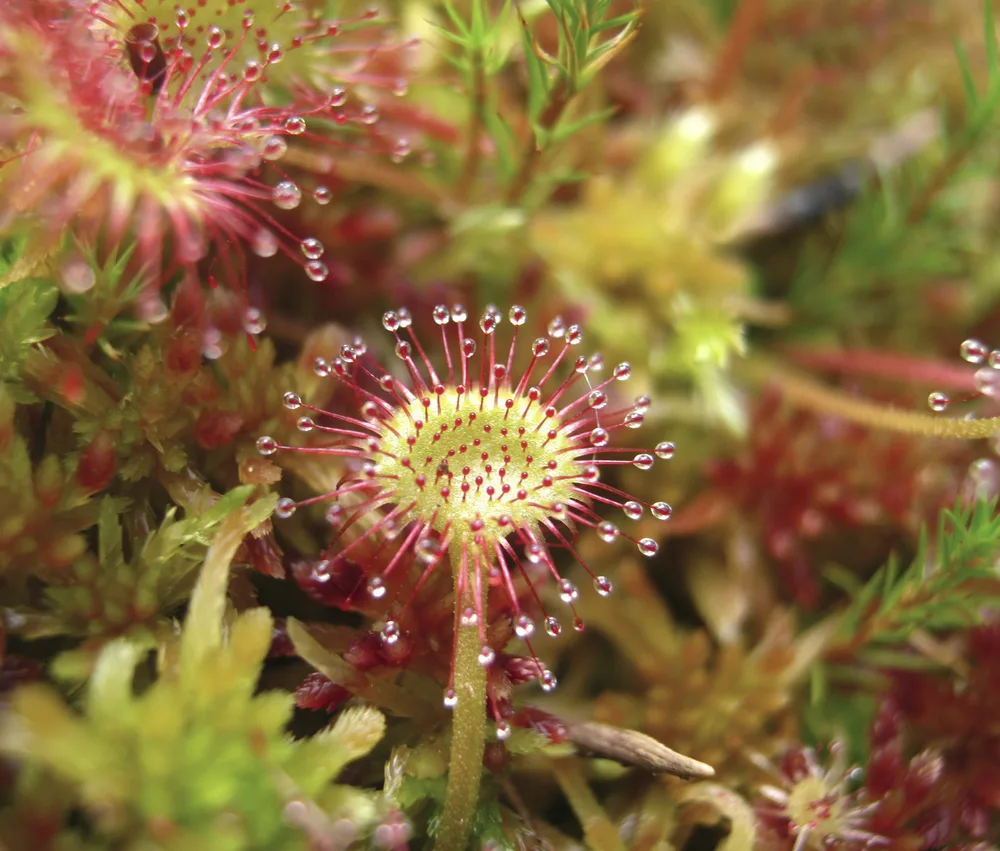
Sundews (Drosera) are another trapping plant on the more attractive side, in name and in appearance. Thriving in temperate and tropical regions, this plant enjoys more sandy acidic soil.
Sundews’ traping mechanisms are quite interesting.
Their leaves have mutated to form sticky pads with even stickier hairs. These hairs, which are more tentacle-like than anything else, secrete the sticky substance from their bulbed tips. This attracts its prey which ranges from flies to mosquitos.
Once an insect finds itself stuck, sundews wrap its tentacles around itself, closing its prey in. Enzymes digest the prey, and after about a week, it uncoils itself, waiting for the next snack.
There are several types of sundews to choose from, the most common being the round-leafed sundew.
These are vinelike, growing to approximately 10 inches tall. There are other varieties though that lay low, like the spoon-leafed sundew. The Cape sundew, native to South Africa, thrives in warmer climates in the US and is another favorite, mainly due to its long leaves and the pretty pink flowers it produces.
Pitcher Plants
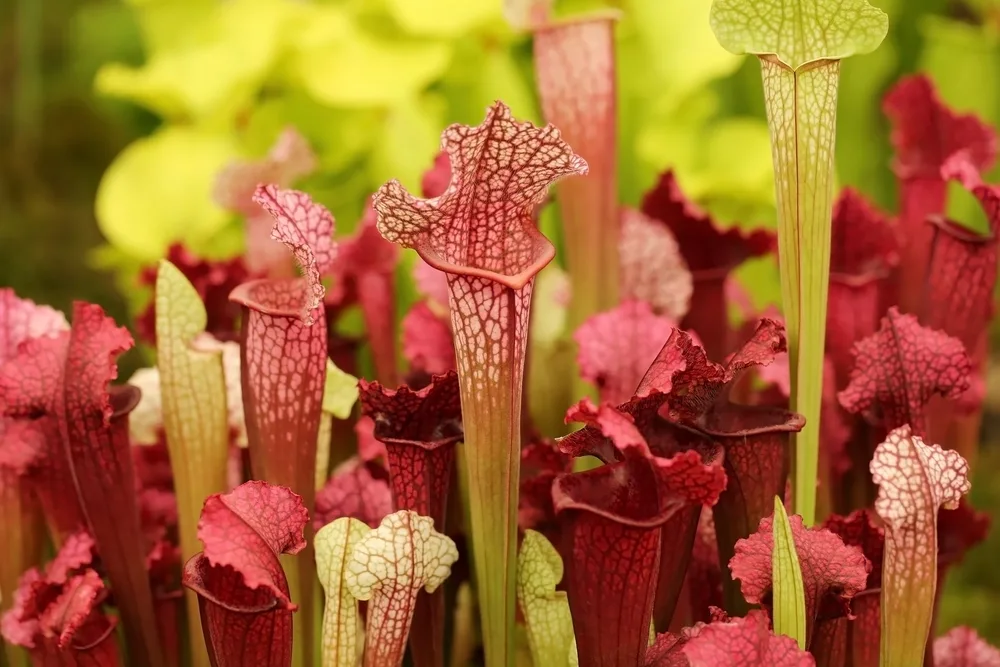
For the more experienced green thumbs, opt for pitcher plants. These interesting plants liven up any space with their elegant and bright leaves. You may not think they’re carnivorous when you first see them, but their tubed leaves expertly trap insects. In the wild, small animals form part of the menu.
Pitcher plants attract prey with their smell and bright colors. Its vase-like traps are slick and lined with small hairs, making it difficult for prey to escape. Water tends to collect inside these leaves too, drowning the prey. Some varieties even produce a chemical that kills the unlucky pest instead. This chemical liquid lays at the bottom of the vase and acts like quicksand. The more the prey struggles, the more they’re pulled down.
There are several varieties of pitcher plants. Some have different methods of attracting and trapping prey. But all are fascinating to look at. From colors to styles of pitchers, you won’t be disappointed.
Pitcher Plant Varieties To Choose From
An elegant, minimalist choice is the Sun pitcher plant (Heliamphora). There are several subspecies to choose from – differing in color – the most popular having dark red hues. Sun pitchers all have bell-shaped flowers.
Unfortunately, they’re quite picky and can be difficult to care for. Your humidity and temperature levels need to be perfect to keep this plant happy.
A popular choice among many gardeners is Purple pitcher plants (Sarracenia). These are unfortunately the most susceptible to the pests and diseases we spoke of earlier. They’re also very thirsty, more so than other carnivorous plants. Despite this, they’re a marvel to look at. Their deep purple pitchers with intricate veins make it a spectacle plant that you’ll definitely want in your home.
Of course, we can’t leave off Cobra lilies (Darlingtonia californica). Its interesting name comes from the shape of its leaves. They curl, forming a shape that resembles the head of a cobra snake. They’re part of the unique pitcher plants that don’t catch rainwater. Instead, they have a chemical puddle at the bottom of the long tube that kills their prey.
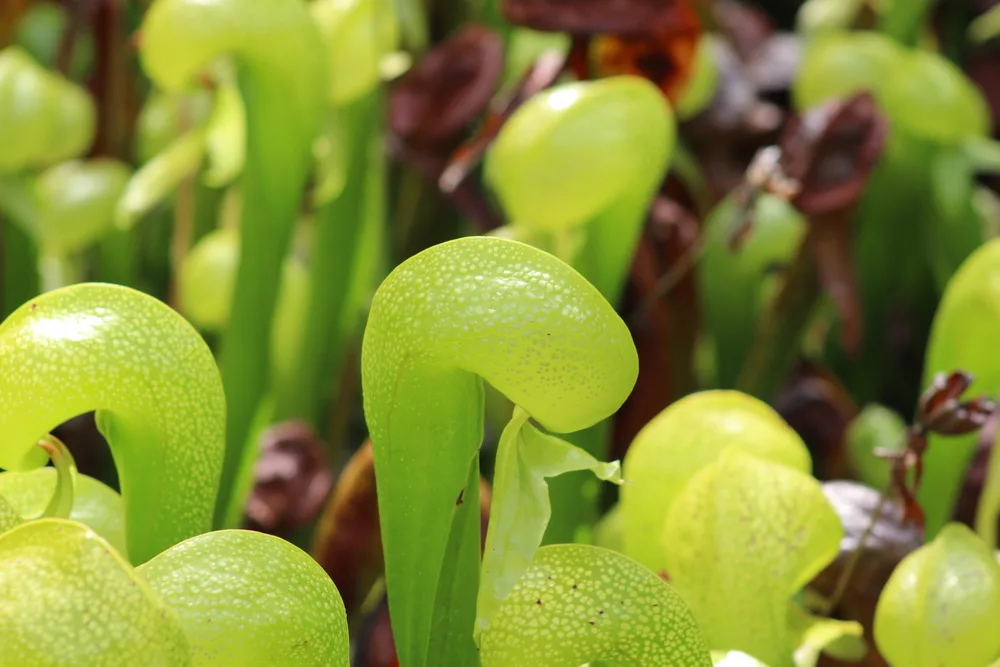
They’re also quite difficult to grow. Cobra lilies are fussier than other carnivorous plants. They need to remain cool and don’t do well in warmer regions. They also need cold rainwater or distilled water. Some even suggest placing ice cubes on the soil to help keep the roots cool.
As scary as they may seem, carnivorous plants make a great addition to any home.
They’re interesting to look at, not only when they’re on display but when they’re hard at work too.
Carnivorous plants make great companions for the home, ridding your kitchen of pesky flies, gnats, and mosquitos. Most are easy to care for and will remain vibrant and hungry as long as you meet their water and soil needs.
There is a carnivorous plant for everyone. Whether you’re a beginner or an experienced home gardener, you have a plethora of choices waiting for you.

Get the famous Rural Sprout newsletter delivered to your inbox.
Including Sunday musings from our editor, Tracey, as well as “What’s Up Wednesday” our roundup of what’s in season and new article updates and alerts.

